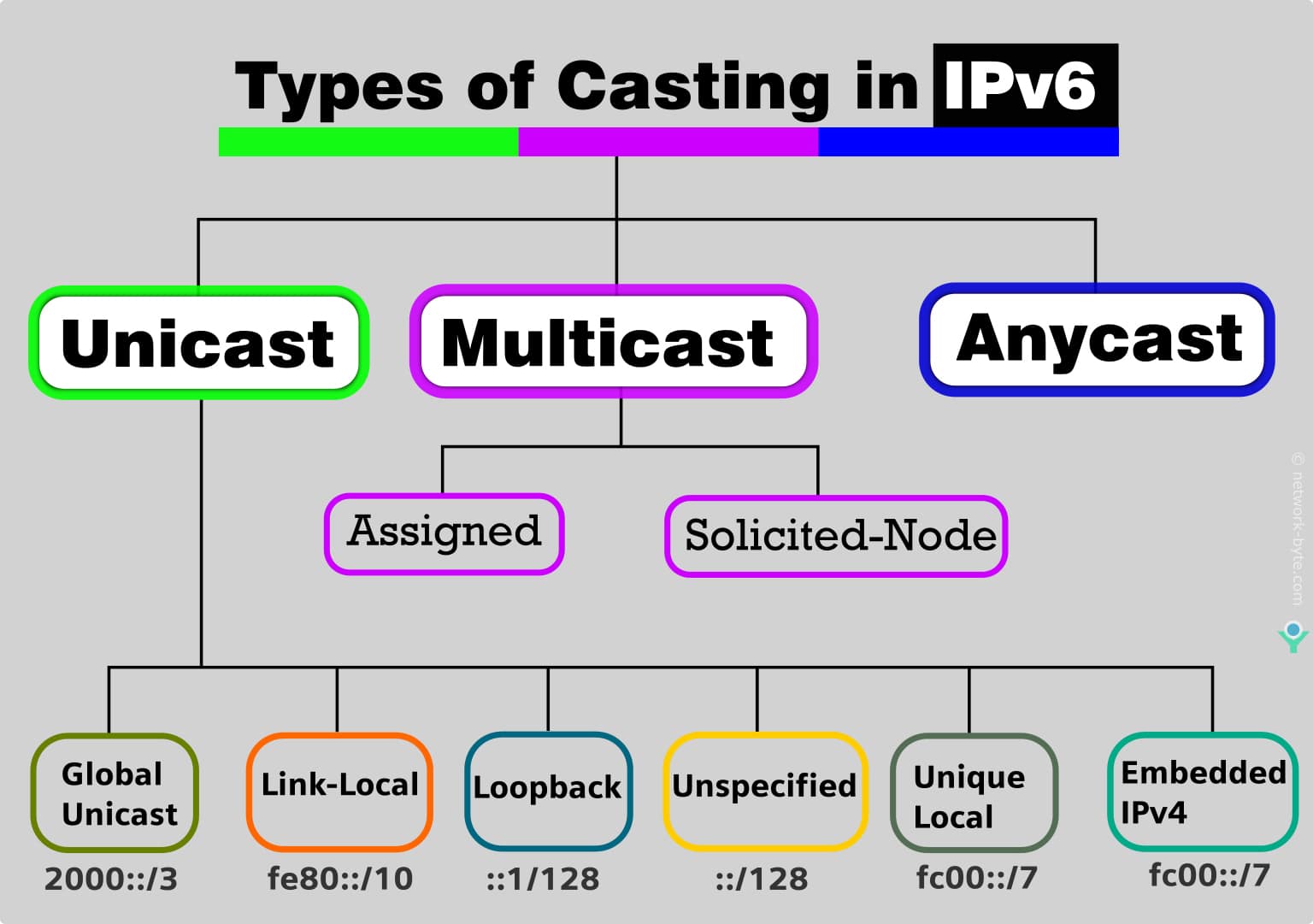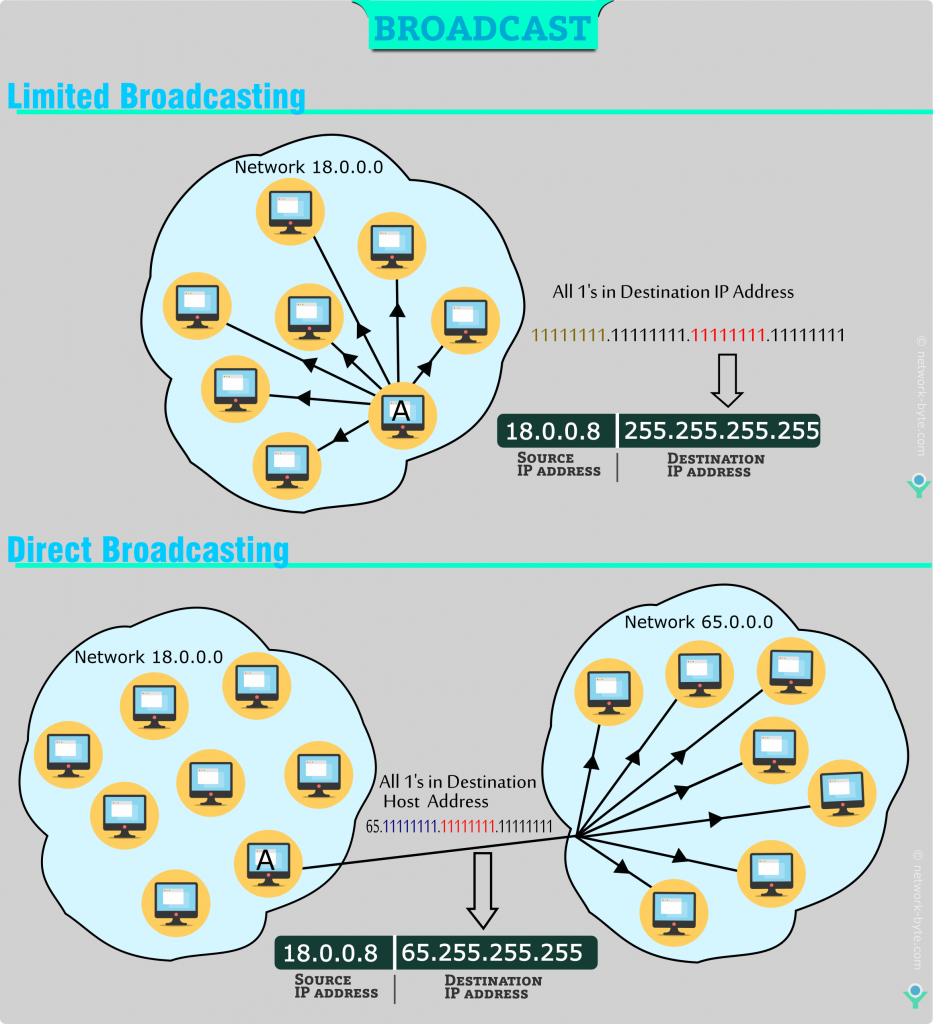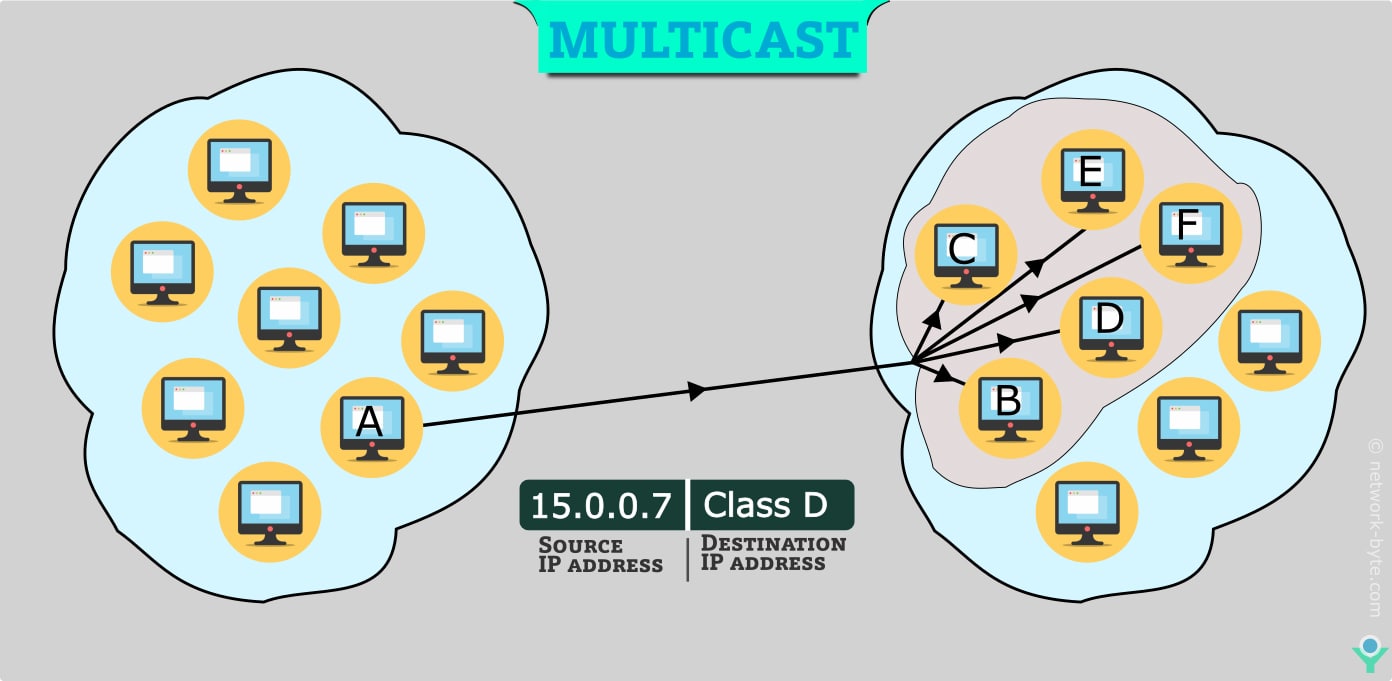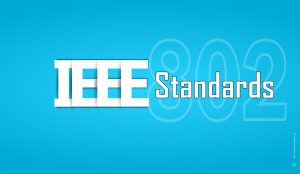In a network technology, the messages are sent using a number of tasks which is undertaken in order to successfully transmit the data from one place to another. One of the methods is simply the addressing of the message that is putting an address on it so that the system transmits it to the right place. The other it transmitting the message, which is sending it to the intended recipient.
There are three types of traffic we choose in our network in IPV4
- Unicast
- Broadcast
- Multicast

Here the suffixes “Cast” signifies stream of packets transmitted over the network.
in ipv6 we have three types of traffic but here Broadcast is not used one additional that is anycast
- Unicast
- Multicast
- Anycast

UNICAST
The prefix “Uni” means single where data is sent from one sender to one receiver. It is also known as one-to-one transmission.

Here in the above figure Host, A having IP address 10.0.0.55 want to send data to Host B having IP address 85.0.1.6 then this connection established is known as Unicast. This is the most common form of data transfer over the networks.
For Example, your are Browsing a website like www.network-byte.com here your system is the receiver and the web server is the sender or uploading a file using an FTP server act as the receiver and our PC act as the sender
In unicast both sender and receiver have a unique IP address. In IPv6 unicast has various flavor as discussed below
Global unicast: also known as aggregatable global unicast addresses, A routable address in the IPv6 Internet, similar to a public IPv4 address. 2000::/3 addresses (IPv6 addresses starting from 2000 to 3FFFF)to the global pool for unicast.
Link-local: Used only to communicate with devices on the same local subnet link. Routers do not forward packets with these addresses. Address range from fe80 to febf.
Loopback: sends out signals back to the same computer for testing. In ipv4 most commonly used IP address on the loopback network is 127.0. 0.1.The IPv6 loopback address is 0:0:0:0:0:0:0:1,which can be notated as ::1/128.
unspecified address: It is used to indicate the absence of an address. It is equivalent to the IPv4 unspecified address of 0.0.0.0. The unspecified address is never assigned to an interface or used as a destination address.The address 0:0:0:0:0:0:0:0 (::/128) is called the unspecified address.
Unique local: Unique local addresses are also known as private IPv6 addresses or local IPv6 addresses. It is not routable on the internet.addresses range from fc00::/7 to fdff::/7
IPv4 embedded: IPv4 embedded addresses carry an IPv4 address in the low-order 32 bits. These addresses are used to represent an IPv4 address inside an IPv6 address.
BROADCAST
In Broadcast where data sent from one computer to all the device. It is one-to-all transfer. There are two type of broadcasting Limited Broadcasting and Direct Broadcasting. It is Ipv4 specific. In IPv4,a host needs broadcast communication when it does not know the receiver’s address.
At layer 2 i.e Data Link Layer broadcast frame has the value of FFFF.FFFF.FFFF (all binary ones) in destination field. The switch will flood broadcast frames out all ports except the port that it was received on.
IPv6 does not include a broadcast address/broadcast domain instead ipv6 uses multicast

Limited Broadcasting-When data send from one host to all hosts in the same network. consider above figure where host A having IP address 18.0.0.8 want to send data to all host in its 18.0.0.0 network. In the data packet, the source address would be 18.0.0.8 and in the destination address all 1’s in 32 bit that gives 255.255.255.255 in dotted decimal notation. in that way limited broadcasting performs.
Router doesn’t broadcast
Direct Broadcasting-when data is transfer to all the hosts in other networks. Consider the above figure where host A having IP address 18.0.0.8 want to send data to all host in another network that is 65.0.0.0 in this case in destination address host bit’s will be all 1’s. Here in our case host is of 24 bit so all 24 bit is replaced by 1’s that become 65.255.255.255 in dotted decimal notation .in that way Directed Broadcast perform.
Multicast
Multicast is a one-to-many type of communication. one/more senders and one/more recipients participate in data transfer. The host which is a member of the multicast group can accept data. We send a message from one source to a group of receivers we use multicast.

Consider in above fig host A send a multicast packet. The member of the multicast group host are B, C, D, E, F so, the multicast packet sent by host A will not be received by all host it only received by members of a multicast group member in our case i.e. B, C, D, E, F
Class D address used for multicast ranges from 224.0.0.0 to 239.255.255.255 these addresses used as destination addresses, not source addresses. A packet sent to a multicast group always has a unicast source address. A multicast address can never be the source address.
Ipv6 multicast address uses the prefix ff00:0000:0000:0000:0000:0000:0000:0000/8 ( FF00::/8),Which is equivalent to the IPv4 multicast address 244.0.0.0/4. Ipv6 has many different types of multicast addresses for different purposes. EIGRP for IPv6, OSPFv3, and RIPng routing protocols use multicast addresses to communicate between router neighbors.

Multicast can’t be implemented on the internet. Video Stream companies like Netflix, Youtube uses lots of unicast address. Multicast on the internet used by Local ISP, They use multicast for IPTV to deliver video to their own customers. We also required application that support multicast like VLC media player.
IGMP(Internet Group Management Protocol -Version 1,2,3) protocol also CGMP(Cisco Group Management Protocol) cisco proprietary used by the host to tell the router/server they which multicast traffic they want to receive.
IGMP snooping to help the switch figure out where to forward multicast traffic of the connected port.
In between router to forward multicast traffic accomplish by
- DVMRP (Distance Vector Multicast Routing Protocol)
- MOSPF(Multicast Open Shortest Path First)
- PIM(Protocol Independent Multicast)
The most popular multicast routing protocol is PIM
Multicast MAC address In 48bit MAC address 24-bit MAC address prefix 01-00-5E is reserved for multicast so the range become 01-00-5E-00-00-00 to 01-00-5E-FF-FF-FF example below
OSPF >>Multicast MAC 01:00:5E:00:00:05 & 01:00:5E:00:00:06
EIGRP>>Multicast MAC 01-00-5E-00-00-0A.
Anycast
Anycast address in IPv6 is an address that is assigned to more than one interface. Typically, the address belongs to different nodes/devices. A packet that is sent to an anycast address is routed to the nearest interface that has that address.
ipv6 Anycast is one to a neighbor or the next one to the nearest association
There is no special prefix for an IPv6 anycast address.
The determination of the “nearest” router is calculated on the basis of the number of hops, distance, efficiency, Latency, and cost.

I’m browsing Youtube/Facebook or Google or some other large platform it has probably a bunch of data centers all around the world. Here in the above fig suppose we have four servers at a different location but having the same ipv6 address i.e. 2001:DA::2
It would be more efficient for me to talk to my nearest data center or would it be more efficient for since I’m in Texas right now would it be more efficient for me to talk to a server in Sweden or maybe Japan or somewhere else well near to me i.e Oklahoma it would be more efficient and faster for me to talk to a server perhaps Oklahoma here somewhere right now. I travel all the time though so maybe when I’m back in California I’m talking to one of the data centers on Oregon maybe when I’m in Florida or Georgia or Alabama or somewhere maybe I’m talking to one of datacenter up in Georgia help speed up this connection so, any casting basically is a one to next or one to the nearest type of communications Basically multiple devices end up sharing the same ipv6 address we’re essentially trying to find who is the closest server or neighbor or client that actually is assigned that particular ipv6 address
More than one computer can’t have the same IP address and for the most part that’s true in this kind of scenario we’re actually assigning the same ipv6 address to these different systems and we’re basically trying to find what the nearest instance of that is.






